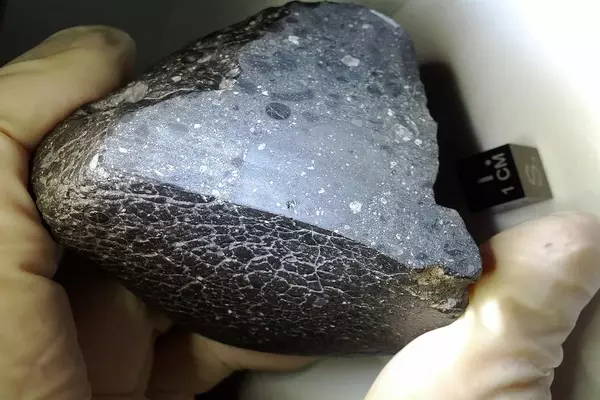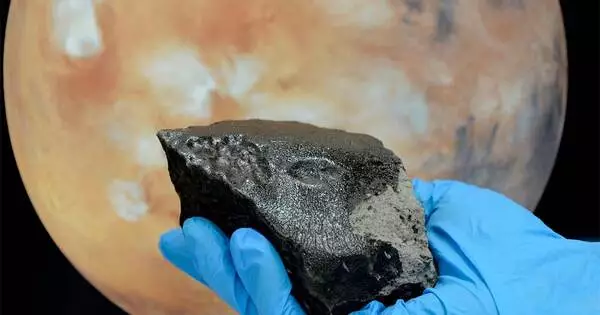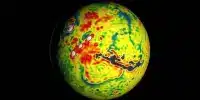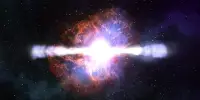What are the similarities between Mars and Iceland? Not so much these days. However, it’s possible that the Red Planet had a crust similar to Iceland today more than 4.5 billion years ago. This discovery, hidden in the oldest martian fragments discovered on Earth, may provide information about our planet that has been lost over billions of years of geological movement and may help explain why the Earth developed into a planet that supports a diverse range of life while Mars did not.
These findings come from a new study published today in Nature Communications by an international team led by a NAU researcher. The study describes how they discovered the likely martian origin of the 4.48-billion-year-old meteorite known colloquially as Black Beauty. Its origin is one of the oldest regions of Mars.
“This meteorite recorded the first stage of Mars’ evolution and, by extension, the evolution of all terrestrial planets, including Earth,” said Valerie Payré, a postdoctoral researcher in the Department of Astronomy and Planetary Science. “Because the Earth’s old surface was lost primarily due to plate tectonics, observing such settings in extremely ancient terrains on Mars provides a rare window into the ancient Earth surface that we lost a long time ago.”
We know the geological context of the only brecciated Martian sample available on Earth for the first time, 10 years before NASA’s Mars Sample Return mission is set to send back samples collected by the Perseverance rover currently exploring the Jezero crater.
Anthony Lagain
What Mars can tell us about Earth
The team, led by Anthony Lagain of Curtin University in Australia, looked for the origin of a martian meteorite (officially named NWA — Northwest Africa — 7034 for where it was found on Earth). This meteorite, whose chemistry indicates that Mars had volcanic activity similar to that found on Earth, recorded the first stage of Mars’ evolution. Although it was ejected from the surface of Mars five to ten million years ago as a result of an asteroid impact, its source region and geological context remain unknown.
This team studied the chemical and physical properties of Black Beauty to determine where it came from; they discovered it was from Terra Cimmeria-Sirenum, one of Mars’ most ancient regions. It could have a surface similar to Earth’s continents. Finding the right impact crater on a planet like Mars can be difficult.
In a previous study, Lagain’s team developed a crater detection algorithm that uses high-resolution images of Mars’ surface to identify small impact craters, discovering approximately 90 million as small as 50 meters in diameter. In this study, they were able to pinpoint the most likely ejection site: the Karratha crater, which excavated ejecta from an older crater known as Khujirt.

“We know the geological context of the only brecciated Martian sample available on Earth for the first time, 10 years before NASA’s Mars Sample Return mission is set to send back samples collected by the Perseverance rover currently exploring the Jezero crater,” said Lagain, a research fellow in Curtin’s School of Earth and Planetary Sciences. “This research paved the way for the discovery of the ejection sites of other Martian meteorites, allowing us to create the most complete picture of the Red Planet’s geological history.”
Payré studies the nature and formation of Mars’ crust to determine if Earth and Mars share a common past that include both a continent-like and ocean-like crust. She uses orbital observations captured in this region to investigate whether traces of volcanism similar to Iceland exist on Mars.
“As of today, the complexity of Mars’ crust is unknown, and knowing the origin of these amazing ancient fragments could lead future rover and space missions to explore the Terra Sirenum-Cimmeria region, which conceals the truth of Mars’ evolution, and possibly the Earth’s,” she said. “This work paves the way for the discovery of the ejection sites of other martian meteorites, which will provide the most comprehensive view of Mars’ geological history and answer one of the most intriguing questions: why did Mars, now dry and cold, evolve so differently from Earth, a thriving planet for life?”
The team’s algorithm has been modified to detect impact craters on Mercury and the Moon, as well as other terrestrial bodies. This can be used to help unravel their geographical history and provide answers to fundamental questions about their formation and evolution. This work serves as a starting point for future Solar System research.














